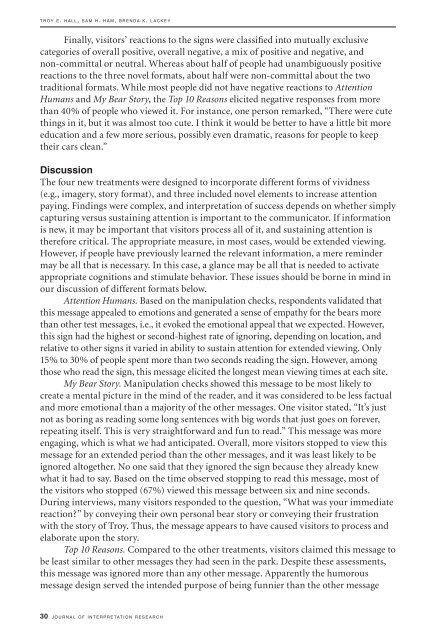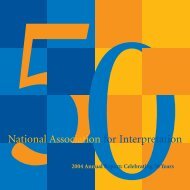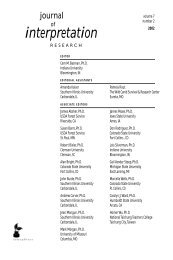interpretation
Volume 15, Number 1 - National Association for Interpretation
Volume 15, Number 1 - National Association for Interpretation
You also want an ePaper? Increase the reach of your titles
YUMPU automatically turns print PDFs into web optimized ePapers that Google loves.
t r o y e. h a l l , s a m h. h a m , b r e n d a k. l a c k e y<br />
Finally, visitors’ reactions to the signs were classified into mutually exclusive<br />
categories of overall positive, overall negative, a mix of positive and negative, and<br />
non-committal or neutral. Whereas about half of people had unambiguously positive<br />
reactions to the three novel formats, about half were non-committal about the two<br />
traditional formats. While most people did not have negative reactions to Attention<br />
Humans and My Bear Story, the Top 10 Reasons elicited negative responses from more<br />
than 40% of people who viewed it. For instance, one person remarked, “There were cute<br />
things in it, but it was almost too cute. I think it would be better to have a little bit more<br />
education and a few more serious, possibly even dramatic, reasons for people to keep<br />
their cars clean.”<br />
Discussion<br />
The four new treatments were designed to incorporate different forms of vividness<br />
(e.g., imagery, story format), and three included novel elements to increase attention<br />
paying. Findings were complex, and <strong>interpretation</strong> of success depends on whether simply<br />
capturing versus sustaining attention is important to the communicator. If information<br />
is new, it may be important that visitors process all of it, and sustaining attention is<br />
therefore critical. The appropriate measure, in most cases, would be extended viewing.<br />
However, if people have previously learned the relevant information, a mere reminder<br />
may be all that is necessary. In this case, a glance may be all that is needed to activate<br />
appropriate cognitions and stimulate behavior. These issues should be borne in mind in<br />
our discussion of different formats below.<br />
Attention Humans. Based on the manipulation checks, respondents validated that<br />
this message appealed to emotions and generated a sense of empathy for the bears more<br />
than other test messages, i.e., it evoked the emotional appeal that we expected. However,<br />
this sign had the highest or second-highest rate of ignoring, depending on location, and<br />
relative to other signs it varied in ability to sustain attention for extended viewing. Only<br />
15% to 30% of people spent more than two seconds reading the sign. However, among<br />
those who read the sign, this message elicited the longest mean viewing times at each site.<br />
My Bear Story. Manipulation checks showed this message to be most likely to<br />
create a mental picture in the mind of the reader, and it was considered to be less factual<br />
and more emotional than a majority of the other messages. One visitor stated, “It’s just<br />
not as boring as reading some long sentences with big words that just goes on forever,<br />
repeating itself. This is very straightforward and fun to read.” This message was more<br />
engaging, which is what we had anticipated. Overall, more visitors stopped to view this<br />
message for an extended period than the other messages, and it was least likely to be<br />
ignored altogether. No one said that they ignored the sign because they already knew<br />
what it had to say. Based on the time observed stopping to read this message, most of<br />
the visitors who stopped (67%) viewed this message between six and nine seconds.<br />
During interviews, many visitors responded to the question, “What was your immediate<br />
reaction?” by conveying their own personal bear story or conveying their frustration<br />
with the story of Troy. Thus, the message appears to have caused visitors to process and<br />
elaborate upon the story.<br />
Top 10 Reasons. Compared to the other treatments, visitors claimed this message to<br />
be least similar to other messages they had seen in the park. Despite these assessments,<br />
this message was ignored more than any other message. Apparently the humorous<br />
message design served the intended purpose of being funnier than the other message<br />
30 j o u r n a l o f i n t e r p r e t a t i o n r e s e a r c h












